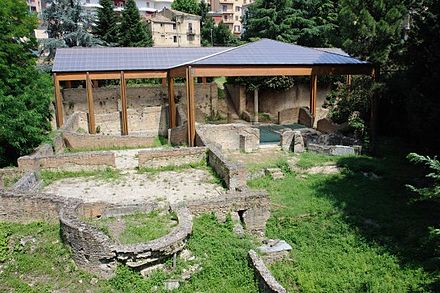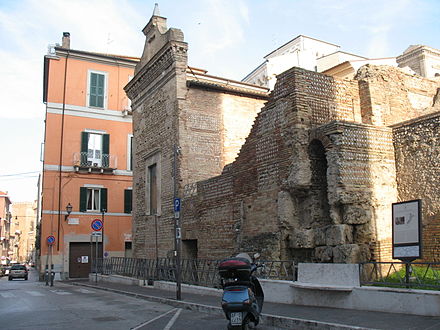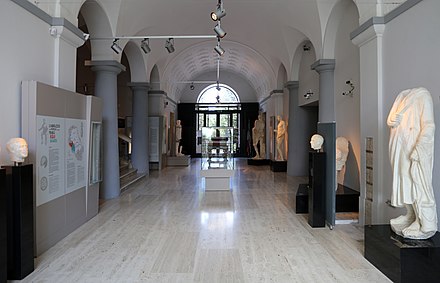Chieti - Italian comune

-dome.jpg/440px-Chiesa_di_San_Francesco_(Chieti)-dome.jpg)
_-_Interior.jpg/440px-Santa_Chiara_(Chieti)_-_Interior.jpg)

 Chieti is an ancient and medium-sized town (2015 pop. 51,945) on the Pescara River, near the Adriatic Sea, in the Abruzzo region of South Central Italy, 200 km northeast of Rome. It's a commercial and industrial center.
Chieti is an ancient and medium-sized town (2015 pop. 51,945) on the Pescara River, near the Adriatic Sea, in the Abruzzo region of South Central Italy, 200 km northeast of Rome. It's a commercial and industrial center.
Known as the town of the chamomile for its tranquility, it offers a wide range of monuments, traces of its glorious and articulated past, but also a delicious urban park, two archaeological museums, and scenic views on Pescara valley, Gran Sasso and Majella mountains.
Understand
Chieti is the capital of the Province of Chieti. The town lies on a crest along the Pescara River a few kilometers away from the Adriatic Sea, with the Maiella and Gran Sasso mountains in the background. It has a fine Romanesque cathedral (11th century), a 14th-century tower, and a university. The order of the Theatine Brothers (founded 1524) takes its name from the ancient Roman town.
The town is divided into two parts: Chieti Alta (that means “Upper Chieti”) and Chieti Scalo. Chieti Alta is the old hill town, while in Chieti Scalo, there are business activities, factories (items manufactured locally include textiles, clothing, fabricated metals, and construction materials), a station and the local university. In addition there also interesting little rural frazioni, such as Brecciarola.
Climate
The climate is genuinely Mediterranean, with influxes from Adriatic Sea (which is 10 km far from the town) and from Majella massif (about 25-30 km), moderate temperatures, and small daily temperature variations. The hottest month is July, while the coldest one is January. In winter the weather can get unusually hot due to foehn winds from the southeast, while winds from the northeast can bring intense snowfalls, with the snow depth that can reach one meter. In summer due to the African anticyclone the daily temperature can exceed 35 °C (95 °F), accompanied by high humidity. Thanks to its exposition, Chieti is among the windiest Italian towns, so summer and spring temperatures are mitigated. The thunderstorms can be vigorous, because the precipitations are relatively consistent and concentrated in few days of the year, especially in winter and autumn.
Neighbourhoods
Quartiere Santa Maria
Also called Trivigliano, it developed with the arrival of Longobards. It occupies the north-east areas of Chieti Alta, included between Largo Santa Maria, Largo Sant'Agata, via Toppi, viale Agostiniani, via Porta Pescara, via Gagliani. Of particular interest are the former convent dedicated to Saint Mary (now barracks), Sant'Agostino church, Sant'Agata church, De Pasquale Palace, Zambra Palace, San Raffaele church, Porta Pescara (which was part of the demolished Chieti's defensive system), and Toppi Palace with its tower
Quartiere San Giustino
Developed around the Cathedral, it includes a large square, part of Corso Marrucino (the main street), the Archbishop's palace, Hernici Palace, via Pollione, and part of via Arniense.
Quartiere San Gaetano
Small neighbourhood located to the east, which includes Largo Barbella, via Marco Vezio Marcello, Largo San Gaetano. It is characterized by Late Middle Ages traits, with small houses close together and 18th-century palaces, surrounding San Gaetano church.
Quartiere San Paolo
Also called Pallonetto, it is located in correspondence to the Longobards' castellum and to the Roman forum, but its aspect has been extensively changed in the 1930s, when the Medieval houses were demolished to build new constructions, like the post office and the De Meis library. In addition to the Roman temples, which were used as a church until 1927, it is worth of mention Fasoli palace.
Quartiere Fiera or Civitella
It is the highest and westernmost part of Chieti Alta, where there is the Roman amphitheater. It still presents the Roman urban principles, with via Ravizza as the Decumanus Maximus and via Napoli and via Smeraldo Zecca as the Cardo maximus. In the Middle Ages, it was used as a cemetery and as a water source, while the Roman architectures were used as building materials sources. The first important architecture in this period were a convent of the Celestines and Porta Napoli. In the 1920s the Medieval houses built on the Roman theater were demolished, and more recently also the Roman amphitheater has been restored. In addition to the Roman architectures, today the neighborhood includes Santa Maria in Civitellis church, Trinità church, Lepri Palace, Filippo Masci high school, La Civitella museum.
Quartiere Terranova
Developed after the period of Longobards, it includes via Arniense, northern part of via Paradiso zone, which is close to Santa Chiara church. The main streets are via Sette Dolori, via Paradiso, Piazza Malta, via Sant'Eligio, via Giuseppe Mezzanotte.
Quartiere Porta Monacisca
Located to the south-east of Chieti Alta, it was founded by Longobards together with the small Mater Domini church, destroyed and rebuilt after the World War II. It includes via Materdomini, via Principessa di Piemonte, via Porta Monacisca, Largo Cremonese, Piazza De Laurentiis, via Cesare De Lollis. It is one of the best preserved neighborhoods, so it presents a lot of monuments, such as the old theater (today called Venetians' Palace), Principessa di Piemonte kindergarten, the former Capuchins' convent, Massangioli Palace, De Sanctis-Ricciardone Palace. However other architectures have been demolished, such as Porta San Giovanni, of which only a basement remains, and an important church, which has been replaced by Marrucino Theater.
Porta Sant'Anna or Piano Sant'Angelo
Founded by Longobards, today it includes Piazza Matteotti, Largo Addolorata, Piazza Garibaldi, via Camillo de Attiliis, via Sant'Eligio, via San Michele, via Nicola da Guardiagrele, via San Giovanni. Even if there are many modern constructions, the urban structure is still partly Medieval, with the most important monuments being Sant'Antonio Abate church, San Giovanni dei Cappuccini church, Sette Dolori church, Santa Maria Maddalena church, and Spinucci barracks.
History
 Traces of Paleolithic settlements dating back to 850,000 – 400,000 years ago were found at Madonna del Freddo's fluvial terraces, while Chieti's hill has been inhabited since 5000 BC.
Traces of Paleolithic settlements dating back to 850,000 – 400,000 years ago were found at Madonna del Freddo's fluvial terraces, while Chieti's hill has been inhabited since 5000 BC.
The town occupies the site of the Roman Teate Marrucinorum, which became the chief town of the Marrucini after the construction of Via Valeria, and of which ruins remain. It was part of the Italic League during the Social Wars, then it was erected municipium in the 1st century BC. During the Roman Empire, it flourished, with the emergence of important families and monumental buildings, but then it was sacked and almost destroyed by Germanic peoples.
Chieti was part of the duchy of Benevento (7th century) under the Longobards, who made it the seat of a powerful county, fell to the Normans (1078), and thereafter belonged to the kingdom of Naples. In 16th century Chieti hosted important archbishops, like the future Pope Paul IV. The 17th century was a period of economic stagnation, but some churches were extensively renovated thanks to the convents. In the 18th century Chieti flourished again under the House of Bourbons, and was enriched with a great number of palaces.
The 19th century was the period of the Italian Unification and of great technological innovations, such as a new aqueduct and the railway station. During World War II, it was declared an open city (like Rome), and was not extensively bombed, so it welcomed many refugees from the near towns and villages.
Get in
By plane
Chieti has no airport, but is about 12 kilometers from Abruzzo Airport
- Abruzzo Airport. It is connected with Chieti thanks to the Chieti-Pescara and Pescara-Chieti bus services operated by TUA and SATAM, and gives access to flights from and to the following destinations: Barcelona-Girona, Brussels-Charleroi, Frankfurt-Hahn, Kraków, London-Stansted, Düsseldorf-Weeze, Milan Linate, Bucarest, Palermo, and Catania. 2020-04-28
By train
Chieti, specifically Chieti Scalo, is crossed by the Rome–Sulmona–Pescara railway, and has two railway stations.
- Chieti railway station. 2020-04-28
- Chieti-Madonna delle Piane railway station. 2020-04-28
By car
Motorways
- Autostrada A25 Roma–Pescara: the main road from Rome.
- Autostrada A14: the second longest Italian motorway, which runs from Bologna to Taranto boarding the Adriatic Sea.
Other roads
- Raccordo autostradale 12: it runs from Chieti's frazione Brecciarola to Pescara.
- Strada statale 5 Via Tiburtina Valeria: named after the correspondent Roman road built around 286 BC on this same path.
- Strada statale 81 Piceno Aprutina: it connects Chieti with Teramo.
- Strada statale 656 Val Pescara-Chieti: a fast way to reach A25 and A14 motorways from Chieti.
Get around
You can use the Chieti's public bus and trolleybus system, provided by Società Unica Abruzzese di Trasporto and La Panoramica, but you can also visit the town center by foot, because it is small and there are many restricted traffic areas, such as the main street (Corso Marrucino) and the urban park (Villa Frigerj). It can be difficult to visit the town center by car due to the traffic limitations and the limited number of parking lots.
See

%2C_an_ancient_Roman_underground_passage.jpg/440px-Via_Tecta_(Chieti),_an_ancient_Roman_underground_passage.jpg)
- San Giustino, Piazza Vittorio Emanuele II, 2. The cathedral is dedicated to Saint Justin of Chieti (died 540). Bishop Atto I consecrated it in 1069, but it stands on the ruins of a precedent church. In 1335 Bartolomeo di Giacomo built the first three floors of the tower, which was completed with the bell cell by Antonio da Lodi in 1498. During the end of 16th century and early 17th century, archbishop Matteo Saminiato restored the church and commissioned the porphyry baptismal font. In 1703 an earthquake demolished tower's spir, and between 1764 and 1770 archbishop Francesco Brancia completely transformed the church. In the middle of 19th century local artist Del Zoppo decorated the vault. In 20th century architect Guido Cirilli consolidated the bell tower, rebuilt the spir, and included the exteriors of the church in a sort of new wall covering. Between 1970 and 1976 the Baroque decorations of the crypt were destroyed in order to bring to light the underlying Early Medieval structure. The cathedral hosts important artworks, such as the wooden choir made in 1769 and the 18th-century paintings by Saverio Persico (in the presbytery and secretariat). The crypt with irregular layout, which is articulated in six small naves, offers to the visitor frescoes dating back to 14th-15th century, and a marble arch, in which are hosted the relics of Saint Justin. Adjacent to the crypt, Mount of the Dead Brotherhood's Chapel, decorated with Baroque gilded stuccoes, hosts a precious altarpiece by Paolo de Matteis.
- San Francesco al Corso church, Corso Marrucino. Franciscans founded this church in 1239. It is considered the second most important one after the cathedral.
- Santa Chiara church, via Arniense. With its rich typically baroque decorations present in the stuccoes, fake dome, and presbytery, this church is the most representative baroque building in Chieti, and resembles other Abruzzo's churches of the 17th-18th century due to its layout articulated in a unique nave and six lateral chapels. 2020-04-30
- San Domenico church, Corso Marrucino. This baroque church was built in the 17th century thanks to Archbishop Sauli. In the oratory there is the Diocese Theatine Museum and religious artefacts are exposed.
- Sant'Agostino church. The church dedicated to Saint Agustin was founded in 1300, almost completely destroyed by a fire in 1562 and totally rebuilt in the 18th century.
- Villa Comunale. It became the civic park when Baron Frigerj sold his mansion to Chieti in 1864. The neoclassical Villa Frigerj is now the home of the homonymous museum.
- Palazzo De Mayo, Largo Martiri della Liberta, 2, +39 0871 359801. The first part of this building was made in the 16th century and it was also restored in the last years of the 18th century by De Mayo, a powerful aristocratic family. The Carichieti Foundation bought this palace and founded an art museum, but unluckily it was closed after the local bank had been declared insolvent.
Ancient Roman ruins
There are some archeological ruins of ancient Teate Marrucinorum, including a theatre, an amphitheatre, thermae and a temple (which was used as a church with the name of SS. Pietro e Paolo). However people are rarely allowed to see also the interior spaces of these monuments.
- Roman temples. 2020-04-30
- Roman theater. 2020-04-30
- Roman amphitheater. 2020-04-30
- Roman thermae. 2020-04-30
- Roman subterranea. At Chieti Alta there are ancient Roman cisterns and other underground spaces. This mysterious heritage was partly explored by Speleoclub, a no-profit organization. In some occasions they organize visits. 2020-04-30
Museums

- National Archaeological Museum of the Abruzzi, "Villa Frigerj", Via G. Costanzi, 2. The rooms of the museum are dedicated to: Burial cults in pre-Roman Abruzzo, Italic sculpture, the Capestrano Warrior, the Pansa collection, the Sanctuary of Hercules Curinus at Sulmona, the Numismatic collection, and Roman Iconography in Abruzzo.
- National Archaeological Museum of Abruzzo La Civitella, Via G. Pianell, +39 0871-63137. The museum is in an important archaeological site, where the ruins of a Roman amphitheatre were found.
- Barbella Museum, Via De Lollis, 10, +39 0871-330873. The 16th-century Martinetti-Bianchi Palace is the home of an art museum, which takes its name from the sculptor Costantino Barbella (Chieti, 1852-1925).
- University Museum of History of Biomedical Science, Piazza Trento e Trieste, +39 0871 410927. The local university manages a museum at the former building of National Recreational Club, an example of fascist architecture. It exhibits a great number of collections, which include prehistoric finds, paleontological finds, rocks, minerals, anthropological materials, historical medical and scientific instruments, contemporary works of art, reconstructions of prehistoric animals, and molluscs.
Do
.jpg/440px-Teatro_Marrucino-olio_su_tela_(Chieti).jpg)
 Under the church of SS. Pietro e Paolo and the adjoining houses are extensive substructures (in opus reticulatum and brickwork) of the 1st century CE, belonging to a building erected by M. Vectius Marcellus (probably mentioned by Pliny, H.N., II., 199) and Helvidia Priscilla. There are also remains of large reservoirs and of an ancient theatre. New excavations are under way on the site of the former Campo Sportivo.
Under the church of SS. Pietro e Paolo and the adjoining houses are extensive substructures (in opus reticulatum and brickwork) of the 1st century CE, belonging to a building erected by M. Vectius Marcellus (probably mentioned by Pliny, H.N., II., 199) and Helvidia Priscilla. There are also remains of large reservoirs and of an ancient theatre. New excavations are under way on the site of the former Campo Sportivo.
- Marrucino Theatre, Via Cesare de Lollis, n. 1, +39 0871 321491. The civic theatre was built in 1818 to become a cultural symbol of the town.
- Good Friday Procession. From historical documented sources, the origins of the procession in its current form date back to the 16th century, even if according to some historians it could be the oldest procession in Italy, beginning in the year 842. It is organized by the Mount of the Dead Brotherhood, a local confraternity.
- Mozart week. It is a week dedicated to Wolfang Amadeus Mozart organized every July, during which Chieti presents to the public 18th-century scenographies, people with 18th-century clothes, dance and stage shows, exhibitions, outdoor movies, fireworks, etc. 2020-04-29
- Nativity play. 2020-04-29
Buy
The ideal place for shopping and visiting the authentic character of the town is the town center, in particular Corso Marrucino.
Eat
Among the local plates there are sagne a pezze, tajarìll fasciule e cotiche, 'ngrecciata , pallotte cace e ove.
- Ristorante Nino, Via Principessa di Piemonte. 2020-04-29
Drink
- Gran Caffè Vittoria, Corso Marrucino 89, +39 347 918. 2020-04-29
Sleep
- Antico Borgo, Via Monaco La Valletta 1, +39 0871 402214. 2020-04-29
- B&B Casa Paradiso, Via Paradiso 29, +39 393 5307932. 2020-04-29
Stay safe
The chances of your experiencing an act of violence in Chieti are among the lowest in the nation, so using common sense is more than adequate. The main natural hazards are earthquakes (the risk is moderate), floods (in some areas in close proximity to Pescara River), landslides and wildfires (especially in some areas surrounding the town center).
It is important to follow all the street rules walking or driving, and, in the town center, respect the restricted traffic areas, in which only the residents are permitted to enter by car.
If you need to contact the emergency services, call 112 (police), 118 (ambulance) or 115 (firefighters).
Stay healthy
The climate is Mediterranean, with hot summers and sometimes consistent snowfall in the winter, so be prepared.
The most important hospitals in Chieti are:
- Ospedale "Santissima Annunziata", via dei Vestini: public hospital with emergency department
- Casa di cura "Giovanni Spatocco", via Giovanni Amendola 93: private clinic
Connect
Go next
- The beach tourism is developed in the seaside resorts of coastal towns, such as Francavilla Al Mare, where a lot of inhabitants of Chieti have their vacation properties.
- In Abruzzo some old villages, places of worship and castles are well-known touristic attractions.
- Abruzzo is appreciated for the mountain tourism and the ecotourism. In the region there are 17 active ski resorts, three national parks, a regional park and 38 protected areas.
Chieti
comune.chieti.itProvince of Chieti
2nd-order administrative division
Abruzzo
Primary administrative division